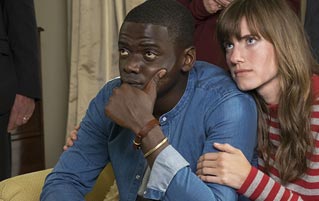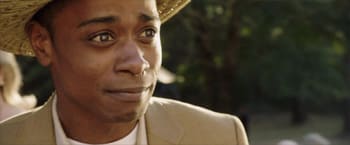5 Horror Films That Just Made Up New Rules Halfway Through

Any good movie needs to establish the rules of its universe. The viewer absolutely must know what happens if zombie blood gets in your mouth, or if you give a gremlin a boner. Unfortunately, not every movie can keep its own rules straight. Some make stuff up right in the middle and hope you won't notice. Spoilers ahead, of course.
In Get Out, The Villains Must Vet And Seduce Their Victims Carefully ... Or Just Kidnap Random People?
One of the major reveals in Get Out is that even white people who voted for Obama can be racist. Another big one is that Chris's girlfriend, Rose, only dated him so that her family could hypnotically trap his mind and auction his body off to wealthy brain-rapists. It's an amazing movie, is what we're saying here.
Anyway, we're first tipped off to the evil plot when Chris discovers a troublingly large stack of photographs of Rose and all her (black) exes, including her parents' weird servants. You might not immediately think, "These are people she's mentally enslaved," but it's worth bringing up.

Rose has been dating Chris for five months. And judging from the intimate photos, she's convinced over a dozen other people to fall for her. This means she has been in the family business of debauching African Americans since she was, at best, a teenager. Forget about how creepy that is; it's sort of incredible. They've been asking this girl to constantly convince strangers to fall in love with her and then betray them since before she could buy beer. She's the Meryl Streep of brain transplant crime.
Using Rose as a honeypot sounds extremely inefficient, but what else could the family do? The movie clearly establishes that they've got to get those people to their house somehow, and it's not like they can simply abduct anyone on the street.
Except ... wait, that's exactly what they can do.

The man in the picture above is Andre. Andre is nabbed while wandering around an upscale suburban neighborhood, presumably looking for an Olive Garden. Rose's brother, Jeremy, lacks his sister's bubbly charm, so he apparently knocks out random black pedestrians and stuffs them in his car.
And it's not like Jeremy's method is any less successful than Rose's. Andre was clearly hypnotized, brain-transplanted, and sold with no real problems. Jeremy achieved in a single night what took Rose five full months.
On top of all of that, Jeremy's method is significantly safer. While she was dating Chris for half a year, she met all the people in his life -- like his friend, Rod, who might wonder why his friend didn't come back from her house. A bisexual girl who dates only black people is already going to generate some gossip, but if every single one of those people mysteriously goes missing, it's safe to say that story would get picked up sooner or later. And a string of abductions linked to the city's most famous interracial sex addict is a much easier crime to solve than a few seemingly unrelated disappearances.
In Freddy Vs. Jason, Jason Randomly Becomes Afraid Of Water
Freddy Vs. Jason was supposed to be the horror villain smackdown to end all horror villain smackdowns. But before the two really go at it, Freddy enters Jason's dreams to see what he fears most. After decades of murder, Jason has been beaten and mangled, sometimes to death, so obviously the thing he fears most is water. Wait, water!?
Specifically, harmless cascading water. It's ... it's weird.
Later in the movie, Freddy uses this knowledge to his advantage. Right when Jason is about to machete the crap out of Freddy, a pipe bursts, spraying wetness between the supernatural forces of death. There's nothing special about this water. It's just water. And it stops Jason right in his tracks. Now, this rule makes sense on paper ... if you've never seen a Friday The 13th movie. As a boy, Jason first died by drowning, so a phobia of water would not be out of the question. Now here's a picture of a very relaxed Jason chest-deep in his greatest fear:

Here he is in Jason Takes Manhattan, wherein he hitches a ride to the big city on a boat's anchor with no problem whatsoever. This is almost certainly the wettest way to get to Manhattan.

Even in a Friday The 13th video game, Jason has no problem getting in the water to do some good old-fashioned lake slaying.

Is it possible Freddy reawakened some dormant fear in Jason? Maybe, but the more likely explanation is that there needed to be some kind of tension in a fight between two immortal fear monsters, and they didn't hire the world's most creative writer to develop the story every seven-year-old horror fan thought of first.
In It Follows, Shooting The Follower Doesn't Work (Until It Does)
It Follows is about a monster that follows you if you bang someone who was already being followed by the monster. Then, if the monster catches you, it bangs you to death. It's uh ... it's better than it sounds. The whole thing is a not-so-subtle metaphor for STDs, so you would imagine the solution to the problem would be some kind of poetic, maybe metaphorical thing, like convincing teens to practice abstinence, or maybe burning off your genitals. But no. Instead they shoot it.
They straight up shoot the thing dead.

Now, shooting isn't a bad idea if you're looking to kill something, but they establish early in the movie that bullets don't work on the Follower. Instead of getting on a plane to Australia to wait it out (because the entity can only very slowly walk wherever it goes), the main group of kids decide to hang out at a nearby beach and let it catch up. Naturally, the monster shows up, and the main character, Jay, shoots it in the neck.
This doesn't keep it down for long. It gets right back up and continues following Jay. This should communicate that it's a mystical being that can't be stopped with mortal techniques, but it doesn't. In fact, the movie soon gets straight up Scooby-Doo. During the big final showdown, the heroes attempt to electrocute the creature in a pool. But when that plan goes belly-up, they decide to finish it off once and for all ... by shooting it. Again.
Maybe it's not a metaphor for STDS, but for how nothing matters and everything's stupid.
When the pool fills with blood, the kids decide the entity is defeated once and for all. Now sure, there's a scene at the end which shows it may (or may not) still be following the characters, but the monster inexplicably showing up at the end of the horror film is a tried and true cliche. It means practically nothing. It's as pointlessly ridiculous as having the monster leap out of the pool on a surfboard and go, "I'll be back in It Follows 2: Beach Bods!"
In 2004's Dawn Of The Dead, People Turn Into Zombies Just, Like, Whenever
A lot of zombie movies play their "zombie rules" pretty fast and loose, but the 2004 Dawn Of The Dead remake reeeally stretched the boundaries of zombification science. Basically, when people get bitten, they turn into zombies whenever it's most convenient for the plot.
In the opening scene, Ana's husband gets bitten in the neck by a zombified neighbor child and collapses on the bed. In the time it takes for Ana to call 9-1-1 and get a busy signal, he dies and pops back up as an undead maniac:

Later, when the gang is in the mall, they bring in a truck full of eight people, two of whom have been bitten. One is a lady in a wheelbarrow, best described as 300 pounds of moaning rotten meat long overdue to die from any number of things. The other is TV's Max Headroom, who has a little bite on his arm.


Max Headroom dies very shortly, but another character, the pregnant Luda, has a similar wound on her arm, and she lasts days, maybe weeks? The movie doesn't give a clear timeline, but within one montage set to a lounge cover of "Down With The Sickness," it's made clear the party is in there long enough to get suicidally stir-crazy.
The point is, Luda lives hundreds, maybe thousands of times longer than other people with the same wound. Maybe her pregnancy had an effect? Meanwhile, the lady in the wheelbarrow seemed to rot into a corpse puddle long before she hopped up as a zombie. Maybe her weight problem had an effect? Is diabetes the cure for zombism?
The characters spell it right out for the audience that bites transit the disease, and yet not a single infection seems to follow the same rules. For instance, the gun shop owner gets bitten on the arm, describes it as "not bad," and turns undead in minutes. Can the zombie virus tell when it's time to speed up the plot?

So turning into a zombie can take several minutes, a few hours, or literally weeks, based on whatever reveal is coolest. Maybe the silliest dramatic transformation happens in the climax, when the Ty Burrell "rich dick" character gets jumped by a zombie and moments later comes back as a hissing monster. Which means that within seconds, a zombie kills him, decides to stop eating him, and leaves the area completely. This goes against everything we've learned about zombie behavior and most of what we've learned about bite timelines, but it allows him to get shot in the face for a callback to earlier in the movie, when Ana said she was going to shoot him in the face.

Saw's central villain, John Kramer, conducts sinister tests on human beings, only allowing them to live if they learn what life really means. The movies clearly want us to think of Jigsaw as a complicated character. Yes, he's a murderous criminal, but also sort of a free life coach? Which may be how they justify letting him win at the end of every movie. (Sorry for spoiling Saw, Saw II, Saw IV, Saw 3D, and Jigsaw.)
There's always some reveal to explain how all the people in Jigsaw's traps deserve it, and unlike his insane proteges, Kramer himself has a single guiding philosophy he's trying to carry out. Supposedly, he forces people to appreciate what they have, and if they demonstrate that they've learned this, he lets them go. But is that really what he does? Is all of this as stupid as it sounds?
Yes. In one movie, he forces a man to tunnel through a maze of razor wire to prove that he wants to live. The man in question does indeed want to live, and is so determined to do so that he slices his stomach open while fighting his way through. So he proves it, right? No, Jigsaw lets him die. It wasn't any kind of test; it was a weird murder with torture and puppets that would have killed him less if he wasn't so motivated to live. Enjoying life isn't the same as being immune to barbed wire, Jigsaw!
The movie is full of traps built around how much damage a body can take, not how determined the body is to seize the day. For instance, the man covered in flammable jelly and made to tread on broken glass without flinching. Jigsaw watches that poor guy through a peephole and doesn't once intervene, even as the guy clearly demonstrates his willingness to endure pain to save his own life. He passed, you dick! Call off the murder!
At one point, Kramer leaves a victim in a chair designed to drill into the man's head if the detectives following him don't call off the case. What kind of zest for life is that supposed to test? Drills don't magically stop working when they hit a brain thinking about how it hates dying.
In the history of Jigsaw's arts and crafts murder spree, only a small handful of people are actually tested on how much they appreciate life. The rest of them are killed in pointlessly unpleasant ways. It's like Jigsaw created the world's most infantile, half-baked philosophy solely to justify thousands of hours of death trap construction and bicycling puppet maintenance. How did they make eight movies about that, and only seven about an evil Leprechaun?
Jordan Breeding also writes for Paste Magazine, the Twitter, himself, and with a dirty, dirty spray can in various back alleys. Mike Bedard does a lot more than point out flaws in movies. He also makes his own. Here's a short he made about Indiana Jones saying it's okay to punch Nazis. If you like what you see, then follow him on Twitter. Dan Hopper is an editor for Cracked, previously for CollegeHumor and BestWeekEver.tv. He fires off consistent A-minus tweets at @DanHopp.
Get to writing your own horror-ific script with a beginner's guide to Celtx.
Support Cracked's journalism with a visit to our Contribution Page. Please and thank you.
For more, check out 6 Hilarious Secret Rules All Horror Movies Obey and 6 Unspoken Rules Every Horror Movie Monster Always Follows.
Also, follow us on Facebook ... Boo!